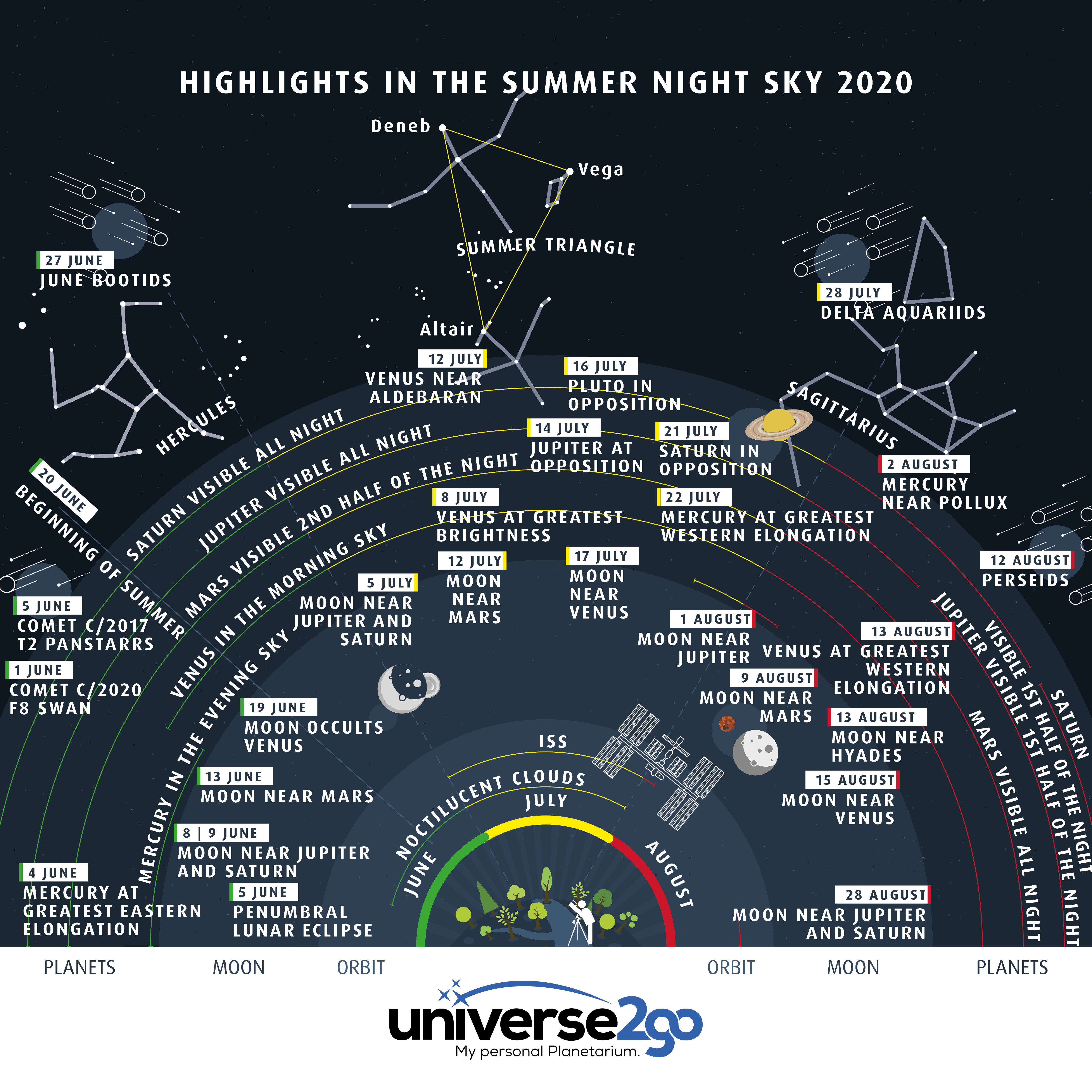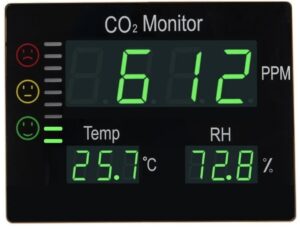Bright comets, fantastic meteors in August and multiple planets at opposition mean that the night sky in summer 2020 is full of astronomical treats.

As early as June, there will be two interesting comets to be seen, namely C/2020 F8 SWAN and C/2017 T2 PanSTARRS. The former is gradually moving from the southern night sky to the northern sky and the latter is maintaining its altitude as a circumpolar object. T2 PanSTARRS is great for telescope viewing – and you can even find it in a great position, right next to a well-known star. More on this later.
We wish you many exciting hours of viewing.
June
1 June SWAN comet
Spring 2020 was rich in comets, one of the most attractive and brightest of these being the comet C/2020 F8 SWAN. It remained in the southern sky in spring, climbed above the horizon at the end of May and can now be found in the northern sky.
4 June Mercury at greatest eastern elongation
Mercury reaches its greatest eastern elongation which, in this configuration, is 23 degrees. It can be seen in the evening sky just above the north-western horizon. When viewed through a telescope, you can see the planet almost half-illuminated.
5 June Penumbral lunar eclipse
This evening, as much as around 50% of the Moon plunges into the Earth’s penumbral shadow. The resulting penumbral eclipse is interesting astronomically but not spectacular visually, as the Moon is only obscured minimally.
We are unable to track the beginning at 19:45 CEST (17:45 UT) because the Moon is still below the horizon. At 21:24 CEST, at the time of its maximum eclipse, it is visible just above the south-eastern horizon. From now on, we can track its further progression until the Moon leaves the penumbral shadow at 23:04 CEST.
5 June PanStarrs comet
Another interesting comet which certainly warrants a quality photo is C/2017 T2 PanSTARRS. It was discovered on 01/10/2017 and has since been travelling around the Sun on a parabolic trajectory.
It is currently at magnitude 8 and is also visible with small telescopes and large binoculars. On 5 June, it will be visible at a distance of 1 degree from the bright star Dubhe (Alpha Ursae Majoris) in the Plough. It will therefore be very easy to find using any telescope and a wide-angle eyepiece or using a large telescope.
9 June Conjunction between Jupiter, Saturn and the Moon
There is rarely a more beautiful sight than this. At the start of the second half of the night, the Moon, Jupiter and Saturn are rising together over the south-eastern horizon. There are only 3 and 4 degrees between both planets and our satellite and together they make an attractive trio. To the right of this we find the constellation Sagittarius with its summer deep sky objects and, to the left, Capricorn.
13 June Conjunction between the Moon and Mars
From around 3:00 CEST (1:00 UT) we experience a conjunction between Mars and the Moon at an altitude of only 10 degrees above the horizon. A stunning sight, but who is this mysterious visitor? Almost invisible, Neptune joins them and can be found no more than 1.5 degrees above Mars with the help of binoculars.
19 June The Moon occults Venus
It is a rare event when the Moon slips in front of Venus today and occults it. However, this event is taking place during the day. But does this mean that you cannot somehow observe it? You can, but this event is more for experienced observers. At 9:55 CEST the Moon, with its narrow crescent shape, slips in front of Venus. Caution: The Sun is around 20 degrees to the east! Never look directly at the Sun with your eyes or using an optical instrument.
27 June June Bootids
The June Bootids meteor shower originates from the constellation Bootes. The number of falling meteors is small but variable. There have been years in which no meteors have been seen, however rates of 100 per hour have been seen on occasion. Because these meteors cause excitement, it is worth taking a closer look.
July
5 July Conjunction between Jupiter, Saturn and the Moon
Once night has fallen, the gas giants Jupiter and Saturn rise, drawing everyone’s gaze towards them at magnitudes of -2.7 and 0.1. Tonight the fully-illuminated Moon joins them, as the Moon was full only yesterday.
8 July Venus at greatest magnitude
Venus is currently located in the constellation Taurus or in the Hyades star cluster. Although it is only 30% illuminated, it is shining at magnitudre -4.4, the brightest magnitude achieved so far this year.
12 July Conjunction between Mars and the Moon
With 2.5 degrees between them, there is a conjunction between Mars and the Moon today. Both are in the constellation Cetus on the border of Pisces and rise after midnight. At sunrise they are 30 degrees above the horizon, they do not reach the meridian as the Sun will have already long risen by then.
12 Conjunction between Venus and Aldebaran
It is a special occurrence when a bright planet passes by a bright star. Events like these are very eye-catching and appealing to observe. On 12 July, Venus passes by the bright star Aldebaran at a distance of only 0.5 degrees. It is to be the closest encounter of any planet with Aldebaran in this century.
14 July Jupiter at opposition
Jupiter rises in the south-east as early as twilight and can be seen as a very bright object. Today it is at opposition to the Sun and can be admired throughout the entire night. A mere 619 million kilometres separate it from Earth and the light requires a little more than half an hour to reach us. Its visible diameter is 47 arc seconds and it crosses the meridian, and therefore achieves its best visibility, at 1:25 CEST (23:25 UT).
16 July Pluto at opposition
The former planet and current dwarf planet is at opposition and is shining at a magnitude of 14.2. Finding it with a telescope which only works with one accurate star chart is a challenge. Pluto is located between Saturn and Jupiter on these days, from which it is only 2 degrees to the west (on the left of the central Telrad ring).
17 July Conjunction between Venus and the Moon
A delightful sight in the morning sky in the form of today’s conjunction between Venus and the very narrow and almost 26-day-old crescent Moon in the constellation Taurus, close to the star Aldebaran.
21 July Saturn at opposition
July is the month of oppositions and today’s offering is Saturn. At magnitude 0.1, it will be shining much more faintly than its prominent colleague, Jupiter. However, Saturn is able to make up for this with its attractive rings, which we are able to see fully exposed in our view.
22 July Mercury at greatest western elongation
Whilst Mercury was at its greatest eastern elongation in June, it is now at its greatest western elongation. This means that it has now become an object in the morning sky, as it now rises before the Sun. From 4:30 CEST (2:30 UT), you should be able to see it at around 3 degrees above the horizon. At this time, the Sun is 8 degrees below the horizon.
28 July Delta Aquariids
The last event this month is the Delta Aquariids. These are shooting stars which appear to come from region containing the constellation Aquarius, at a maximum frequency of 25 per hour. The period after midnight, when the Moon has already gone down, is best suited for their observation.
August
1 August Conjunction between Jupiter and the Moon
Today there is a conjunction between the 12-day-old and almost full Moon and Jupiter.
9 August Conjunction between the Moon and Mars
This morning the Moon is approaching the planet Mars until it is around 2.75 degrees away. While Mars is in Pisces, the Moon crosses the border from Cetus to Pisces in the morning.
12 August Perseids
The absolute highlight of every August is the Perseids meteor shower. We are able to see up to 100 meteors per hour tonight. Admittedly, this is only because the Moon is not interfering. This year, we are able to view them during the first half of the night without it interfering. At 0:30 CEST (22:30 UT) the Moon rises above the horizon, the sky gets brighter and the faint Perseids are drowned out by Moonlight.
13 August Venus at greatest western elongation
Venus is the morning star and is currently at its greatest western elongation at a distance of 45 degrees between it and the Sun. When you view Venus through the telescope, it appears half-illuminated.
13 August Conjunction between the Moon and the Hyades
The Moon is in the constellation Taurus, close to the Hyades star cluster.
15 August Conjunction between Venus and the Moon
Anyone looking up at the sky in the early hours of the morning can see Venus close to the narrow crescent Moon. Both are in the constellation Gemini.
28 Conjunction between Jupiter, Saturn and the Moon
This evening there is a conjunction between the Moon, Jupiter and Saturn in the constellation Sagittarius. The trio is on the left, close to the well-known Teapot asterism. If deep-sky observation is not possible today, how about a tour of the lunar craters, culminating in a glimpse of both rulers of the solar system?



